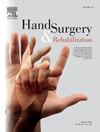超声引导下针刀松解治疗屈指肌腱膜狭窄性腱鞘炎:一项前瞻性随机对照试验。
IF 0.9
4区 医学
Q4 ORTHOPEDICS
引用次数: 0
摘要
目的:本研究旨在评估超声引导下针刀松解术治疗屈指肌腱膜狭窄性腱鞘炎的有效性和安全性:在这项前瞻性试验中,60名经临床和超声波检查证实患有屈指肌腱膜狭窄性腱鞘炎的患者被随机分配到3组中的1组:超声引导下针刀松解术组(20人)、传统保守治疗组(20人)和开放手术组(20人)。主要结果是奎内尔触发严重程度分级。次要结果包括疼痛强度(视觉模拟量表)、满意度(5 点 Likert 量表)和并发症。干预后基线、1周、1个月和3个月的结果由盲人评估员进行评估:结果:在所有随访时间点上,针刀松解组的 Quinnell 分级都明显较低(P 结论:针刀松解组的并发症发生率明显低于针刀松解组:超声引导下针刀松解术是治疗屈指肌腱膜狭窄性腱鞘炎的一种有效而安全的方法,其疗效优于传统的保守治疗,与开放性手术疗效相似。本文章由计算机程序翻译,如有差异,请以英文原文为准。
Ultrasound-guided needle knife release for stenosing tenosynovitis of the flexor pollicis longus: a prospective randomized controlled trial
Purpose
This study aimed to evaluate the efficacy and safety of ultrasound-guided needle knife release in the treatment of stenosing tenosynovitis of the flexor pollicis longus.
Methods
In this prospective trial, 60 patients with clinically and ultrasonographically confirmed stenosing tenosynovitis of the flexor pollicis longus were randomly allocated to 1 of 3 groups: ultrasound-guided needle knife release (n = 20), traditional conservative treatment (n = 20), and open surgery (n = 20). The primary outcome measure was the Quinnell grade of triggering severity. Secondary outcomes comprised pain intensity (on visual analog scale), satisfaction (5-point Likert scale), and complications. Outcomes were evaluated at baseline, 1 week, 1 month and 3 months post-intervention by blinded assessors.
Results
At all follow-up time points, the needle knife release group demonstrated significantly lower Quinnell grades (p < 0.05) and pain scores (p < 0.001) than the conservative treatment group; satisfaction was greater in the needle knife release group compared to the conservative treatment group at 1 month (p = 0.002) and 3 months (p < 0.001). There were no significant differences in outcomes between the needle knife release group and the open surgery group. The overall complications rate was 5% in the needle knife release group, 10% in the conservative treatment group, and 15% in the open surgery group (p = 0.574).
Conclusion
Ultrasound-guided needle knife release is an effective and safe treatment for stenosing tenosynovitis of the flexor pollicis longus, with outcomes that are better than with traditional conservative treatment and similar to those of open surgery.
求助全文
通过发布文献求助,成功后即可免费获取论文全文。
去求助
来源期刊

Hand Surgery & Rehabilitation
Medicine-Surgery
CiteScore
1.70
自引率
27.30%
发文量
0
审稿时长
49 days
期刊介绍:
As the official publication of the French, Belgian and Swiss Societies for Surgery of the Hand, as well as of the French Society of Rehabilitation of the Hand & Upper Limb, ''Hand Surgery and Rehabilitation'' - formerly named "Chirurgie de la Main" - publishes original articles, literature reviews, technical notes, and clinical cases. It is indexed in the main international databases (including Medline). Initially a platform for French-speaking hand surgeons, the journal will now publish its articles in English to disseminate its author''s scientific findings more widely. The journal also includes a biannual supplement in French, the monograph of the French Society for Surgery of the Hand, where comprehensive reviews in the fields of hand, peripheral nerve and upper limb surgery are presented.
Organe officiel de la Société française de chirurgie de la main, de la Société française de Rééducation de la main (SFRM-GEMMSOR), de la Société suisse de chirurgie de la main et du Belgian Hand Group, indexée dans les grandes bases de données internationales (Medline, Embase, Pascal, Scopus), Hand Surgery and Rehabilitation - anciennement titrée Chirurgie de la main - publie des articles originaux, des revues de la littérature, des notes techniques, des cas clinique. Initialement plateforme d''expression francophone de la spécialité, la revue s''oriente désormais vers l''anglais pour devenir une référence scientifique et de formation de la spécialité en France et en Europe. Avec 6 publications en anglais par an, la revue comprend également un supplément biannuel, la monographie du GEM, où sont présentées en français, des mises au point complètes dans les domaines de la chirurgie de la main, des nerfs périphériques et du membre supérieur.
 求助内容:
求助内容: 应助结果提醒方式:
应助结果提醒方式:


